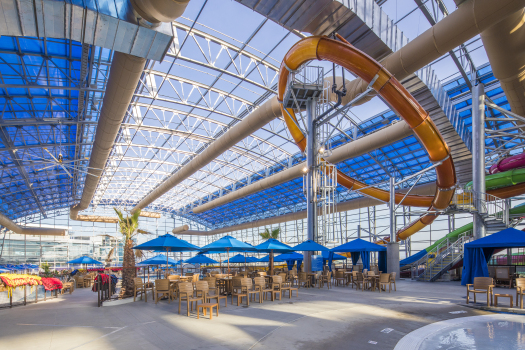The October 2015 edition of Recreation Management featured an article that details how municipal waterparks approach to size and thrills is changing. With the popularity of municipal waterpark increasing, cities are looking for ways to set their waterparks apart from the competition. The article features research from Hotel & Leisure Advisors and comments from H&LA President, David Sangree.
Municipal Waterparks Getting More Competitive
BY: Joe Bush
PUBLISHED: October 2015
Not all waterparks are created equal, but they have a lot in common.
There’s water, sure, but also slides and zero-depth entry, lifeguards, entry fees, seating areas and concessions. The separation begins where the buck stops: Private ownership typically means larger parks and more state-of-the-art features like wave pools and surfing areas and wall slides. And high ticket prices.
These for-profit extravaganzas can be parts of resorts or hotels or standalone, indoor and out, and while their glitz and glamor can be destinations, the gap between them and municipal waterparks is closing. Community parks have historically been smaller with minimal attractions—fewer and smaller slides—but there are more of them in the United States and industry experts say their approach to size and thrills is changing.
“The tide has started to turn,” said Dave Keim, vice president of business development for Aquatic Development Group, a waterpark design and development company in Cohoes, N.Y. “Big municipal waterparks are no longer the exception to the rule.”
Most municipal waterparks are outdoor and standalone. One indoor standout is the 52,000-square-foot Snohomish Aquatic Center run by the city of Snohomish, Wash. Built in 2012-13, it features a 151-foot long slide, a lazy river and a surfing simulator.
A gold standard for all municipal waterparks is Water World, run by the Hyland Hills Park and Recreation District in suburban Denver. It covers 67 acres and boasts 40 different water features, including more than 20 listed in the park’s website’s “Thrills” category.
Municipal parks, no matter their size, have the advantage of proximity, lower entry fees and community service.
The most recent state-of-the-art rides include a hydromagnetic water coaster and Warp Speed, a slide that utilizes slideboarding: In a space wormhole theme riders use controllers embedded in their raft to shoot hazards to try to outscore others. Yes, an aquatic videogame.
Steve Loose, the general manager of Water World, said his park is trying to draw visitors away from not just other waterparks, but Mother Nature as well.
“Our principal competition is any recreational activity or service, including visits to the Rocky Mountains,” Loose said.
Size & Scope
The annual waterpark industry report put together by Hotel and Leisure Advisors (H&LA), a hospitality consulting firm based in Cleveland, Ohio, shows more municipal waterparks than private, and more parks in the Midwest than in other regions. There were 858 waterparks in the United States as of March 2015, 24 more than at the time of the publishing of the 2014 report.
H&LA President and report author David Sangree said the main differences between municipal and private waterparks are their size and the amount that is spent on attractions. Private and public waterpark owners and operators are targeting customers with different priorities, however, so they tend not to hurt one another.
Privately owned parks seek families on vacation who will spend more than a day there, or will use their property as a one-day getaway. Their admission prices demand all-day use, and their revenue must cover not only profit goals but debt service.
Municipal parks, no matter their size, have the advantage of proximity, lower entry fees and community service. Their goal is to re-invest any profits or help fund other municipal projects, and they are not concerned with principal and interest.
“(Municipal parks) definitely do compete, but in general the private facilities are nicer and more elaborate, and the customer is more willing to pay for that and pay the higher prices because they appreciate a more elaborate facility,” Sangree said. “There are some municipalities that spend the money to build a pretty nice facility and in that case it’s almost impossible for the private facility to compete.”
To read the entire article, click here.


